
25 March 2019. You really need to see this place! I know you love a bargain, and this place is full of them. It’s like a massive garage sale that covers several blocks and everyone has something different to sell.
We hadn’t planned on being there. We were going to the Kitano Tenmangu Shrine neighbourhood that day anyway for a geisha performance, Kitano Odori – something I urge you to see if you ever get to Japan – just breathtaking! The first time I went to Japan I went to a geisha performance, Kamogawa Odori, which I’d learned about in pre-trip research, so researching for my second trip, this time with Don, I checked again for geisha performances. We were in luck! The first performance of the season was to be on our last day in Kyoto. I seem to remember you could only buy tickets one week before, so we made sure to do that, first thing in the morning at the tourist office in the train station. With that task done we went on a journey for the day, adventuring to Amanohashidate for a gentle walk along a sandbar, and on to Ine, a unique traditional fishing village. That was a beautiful day.
Our second piece of luck? The Kitano Tenmangu flea market, known locally as Tenjin-san market, is only held on the 25th day of each month, and that was the day we’d be there! We made sure to get there early so we’d have plenty of time to explore before the geisha show.
There are antiques and vintage items,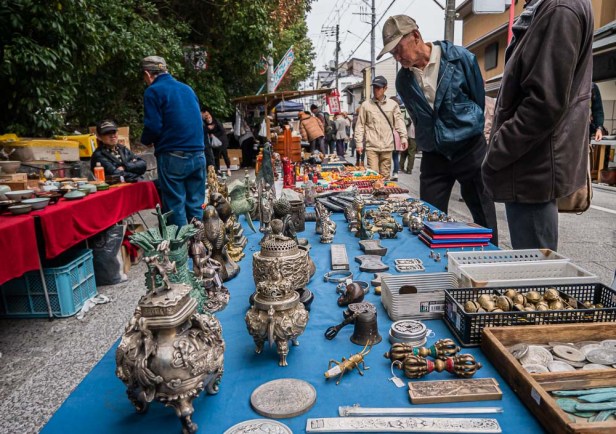
and curios everywhere we look.

I’m constantly stopping to take photos of all the finds that are uniquely Japanese.
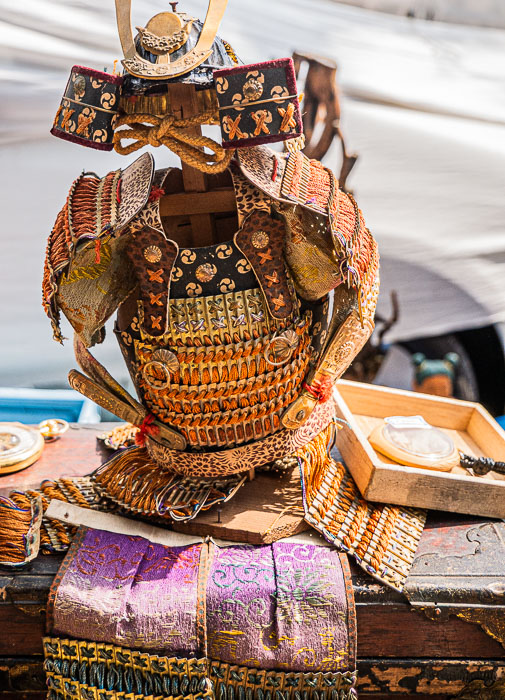
But of course almost everything is uniquely Japanese. Where else would you find a painting of a yellow-eyed cat with its “arms” folded and an expression that says Oh please! I can see right through you!?
The attics and storage rooms of Japan have been emptied out and put on display. Here are both the special artefacts, and the detritus of life spilled out on to the street; picture frames and small furniture,
vinyl records, toys, an old scale, stacks of new dishes,
and beautiful hand made pottery.
All of it has been carried there in boxes, unpacked and spread out, from very early in the morning. It’s a big day. Everyone is hoping to make a sale on this one day of the month that the market is held.
There are antique dolls,
and racks and racks of gently-loved kimono which you buy by the size of the bag you stuff them into,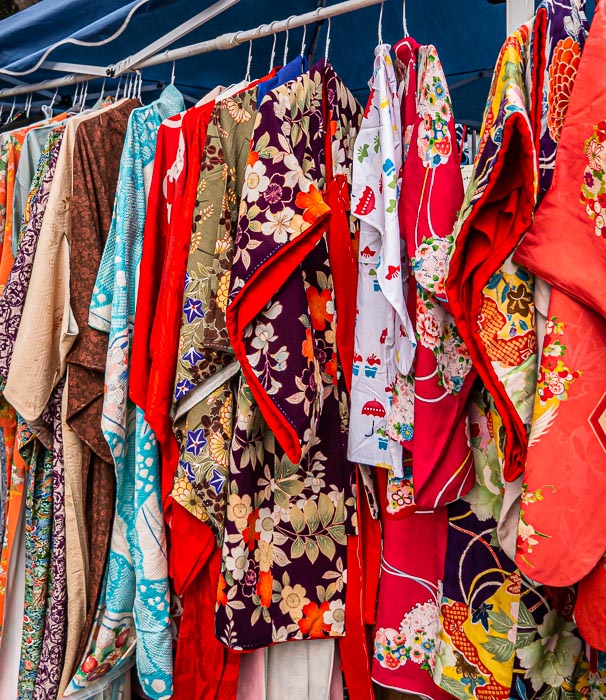
and power cords and half-used spools of thread,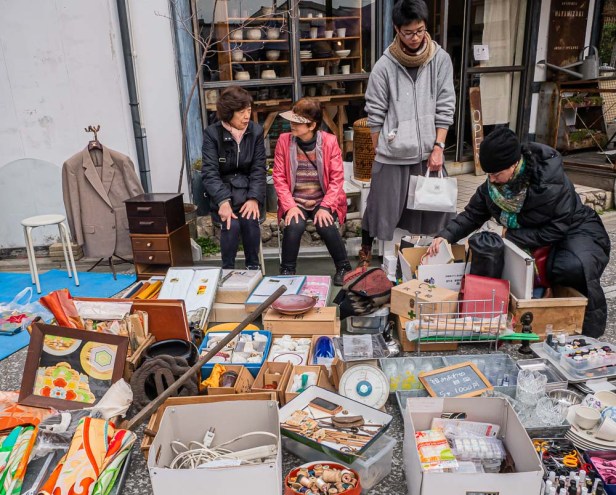
and everything in between.
Where else would you find dolls like these? What is in her mouth? Or is it her tongue sticking out? And rabbits! Dolls and rabbits in beautiful hand made traditional dress.
I’m drawn like a magpie to the colours of these beautiful embroidered purses,
and being into clothes, and sewing, the kimono fabric is enough to make me drool; such beautiful colours and designs.

Speaking of design, this ferocious swordsman on the back of a happi jacket gets my attention,
but then I see the head, perhaps detached from his body by the above-mentioned swordsman, who doesn’t look happy at all,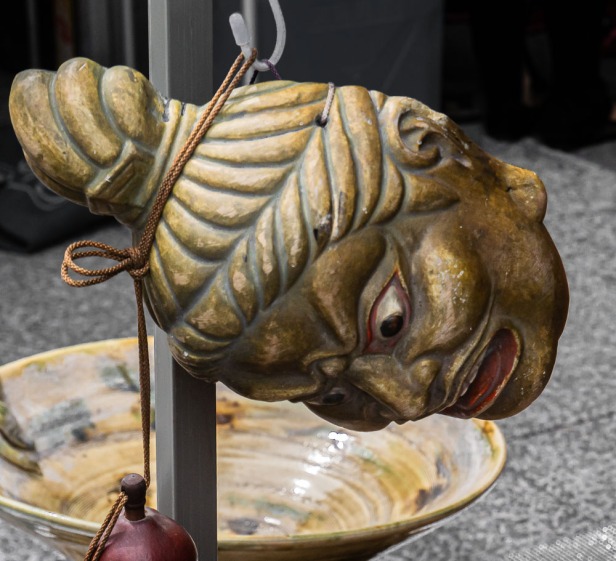
and these guys who look perpetually displeased with life. Don’t mess with me! I’m not in the mood!
About this time we come to the man and his monkey. But perhaps I should say the monkey and his human. Oh I imagine some people will probably have words to say about animal cruelty, and that there shouldn’t be performing monkeys, but how is it different from training a dog, or a horse? No one objects to that. I know, I know, dogs and horses have been domesticated, which puts a different slant on things, but I wonder who it was that did that hmmm? Speaking of domestication, the latest research is indicating that cats probably domesticated themselves. Of course they did.
Anyway, I think this human has had his monkey from when it was a tiny baby, and the love between the two is so palpable,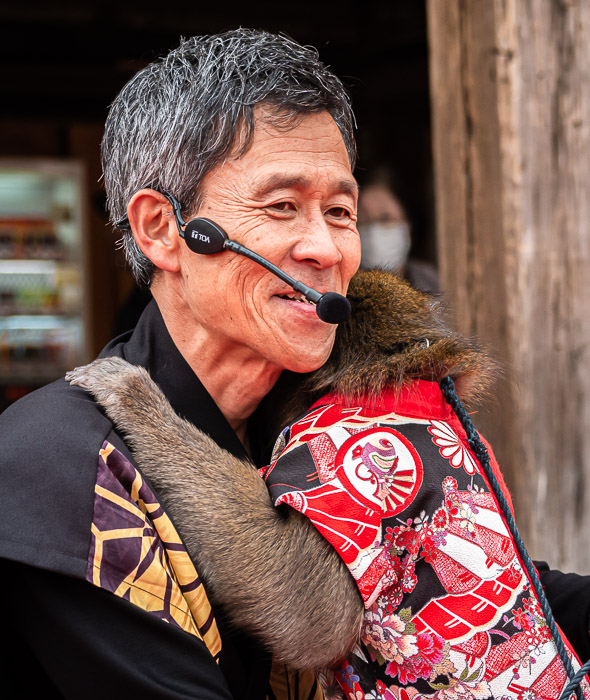
and the monkey looks so healthy that it makes me smile.
It’s such a delightful performance.
It doesn’t matter that I don’t understand a word of what the human is saying, the monkey says it all in his own clever way, and when it’s time to bow, he bends at the waist so low his head is on the ground. The whole audience laughs and claps.
Kitano Tenmangu flea market has the feel of a small-time festival, and the crowds grow as the day goes by.
People stop to buy beautiful buttons (looking at my pictures I regret now that I didn’t buy some for myself)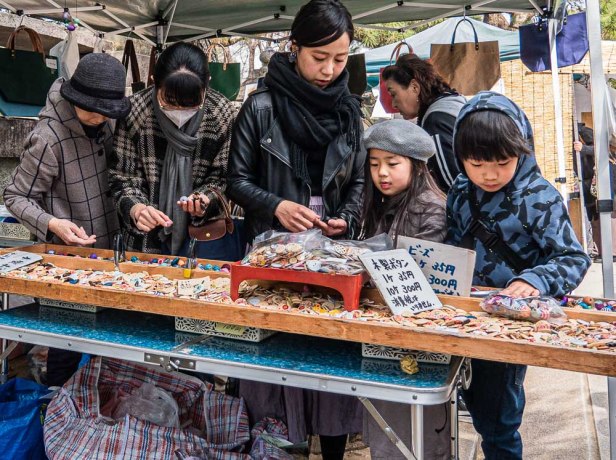

and bolts of cloth,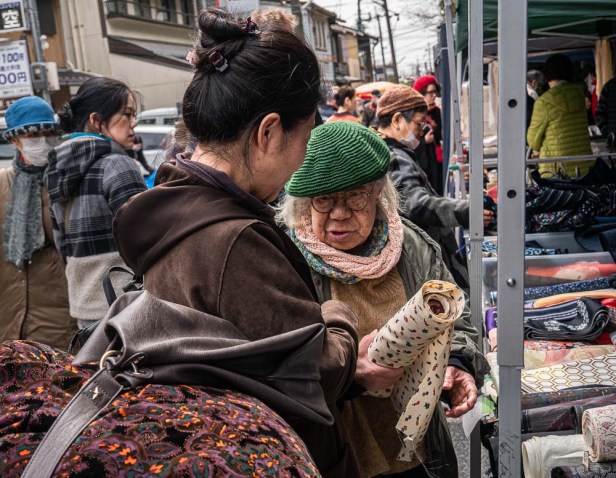
and locally designed and made clothing.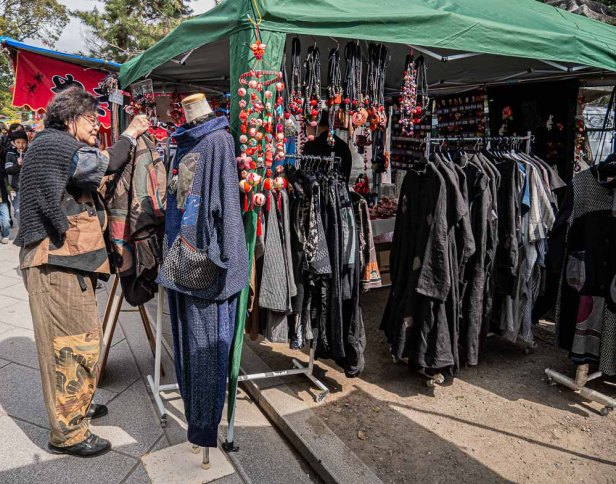
Sales are made,
plants are bought for the garden,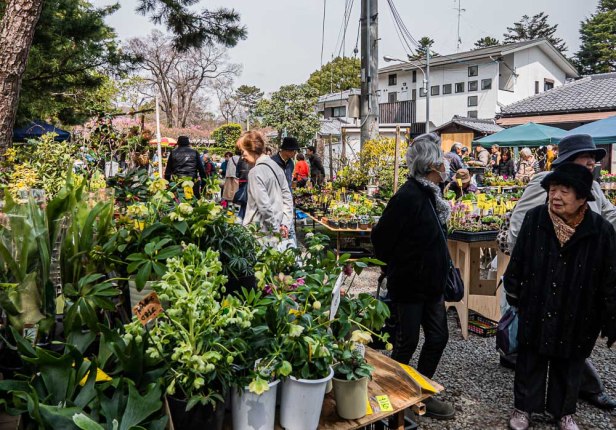
and of course there is food – some to take home,

and some to eat so you have sustenance to continue shopping.
Yakisoba, takoyaki, okonomiyaki, and crepes; so many choices from a multitude of street food vendors.
The whole thing is a vibrant wonderful cornucopia – of food, of people, of beautiful things, and of the minutiae of life. There are over one thousand vendors; people are spoiled for choice. I can imagine that if I lived in Kyoto I’d be at this mini carnival every month poking around for bargains. You never know what you might find, right?
Before I finish this, I just want to whizz over to Nishiki Market. I’ve written about it before, when I was there on a solo trip, but on this second visit to Japan I wanted to share it with Don. And I want to share with you a handful of the photos I took on this second visit.
Nishiki, a narrow street of five covered blocks with a ceiling of rainbow windows,
is known as the kitchen of Kyoto. It is here that you can buy anything food related – cookware, dishes, knives, chopsticks, and of course food, most of which is unfamiliar.

There are also plenty of street food vendors to make sure you don’t go hungry while you shop,

a fan store,
and these two ladies handing out tea samples in beautiful pottery cups. Because it’s Japan no one steals the cups.
And I must share that there is also a standing sake pub. Unless you try too many samples in which case it might become a lying down sake pub.
Nishiki began life in the 1300’s as a wholesale fish market. Over the years it morphed into a retail market selling primarily foods, but also various other goods. There are hundreds of shops and restaurants, many of which have been in the same family for generations, and the market is now a long-standing fixture of ordinary life in the city. I think it should also be included on your list of places to explore if you ever get to Kyoto, especially if you catch a rainy day. Nishiki is real life.
Markets are my among favourite places to visit in new countries. Not the tourist markets selling souvenirs, which have their place, but the local markets where you get a glimpse into the regular life of the people of the country. Both Nishiki and the flea market, neither being a promoted or curated tourist destination, and both being much frequented by local people, gave us a hint of the ordinary life of the people of Japan. So similar, and so different from what I am used to. And then we were off to the geisha performance, which I’ve written about previously, and which is about as far from ordinary life as you can get.
Next post: I think I’ll finish off this series on Japan, so a ride on a tiny open train in the country for ordinary people, and a castle for royalty.
All words and images by Alison Louise Armstrong unless otherwise noted
© Alison Louise Armstrong and Adventures in Wonderland – a pilgrimage of the heart, 2010-2021.

What fun! I love the kimonos.
LikeLiked by 1 person
Thanks Cindy, yes it was. I too love the kimonos – so colourful!
Alison
LikeLike
Kitano Odori, Kitano Tenmangu and Nishiki, great opportunities to delve into Japanese culture, thank you so much for this valuable introduction, and here I bend in the Japanese manner 🙂
LikeLiked by 1 person
Thank you so much Lookoom – bowing back 🙂
All three definitely worth attending. Japan is so rich culturally.
Alison
LikeLike
Ah, the colours and vibrancy of markets!! I love the kimono patterns, the buttons, the art. And look forward to one day strolling down Nishiki Market and visiting the Sake pub – after sampling the local food specialties of course 🙂 What Fun!!
LikeLiked by 1 person
Thanks Surati. Definitely fun. Kimonos everywhere in Japan caught my attention – so colourful, and also some shining with understated beauty. I sooo regret that I didn’t think to buy buttons! That is something for sure I could have fitted into my case. This is just a glimpse into Nishiki, I covered it more in the earlier post – it is a fabulous place and definitely worth visiting – for the food, for the cultural immersion, and yeah, for the sake!
Alison
LikeLiked by 1 person
I am loving your photo journals.
LikeLiked by 1 person
Thank you so much Barb. It’s lovely to hear that.
Alison
LikeLike
What an interesting place! Did you get yourself some souvenirs? 🙂
Regrading the girl dolls, I remember seeing those smiley faces before. On a candy package, if I remember correctly.
LikeLiked by 1 person
It was really interesting, and it was just pure luck that got us there. I didn’t get any souvenirs, but I sure wish now that I’d bought some of those buttons.
Perhaps the candy manufactures created the dolls as a spin-off.
Alison
LikeLiked by 1 person
Markets are such a fascinating part of travel. Like you with the buttons, there are times I return home and think why didn’t I buy that when I was there?
LikeLiked by 1 person
I love markets. It’s the one place you can go (without a guide, and without an invite) and be sure to get a glimpse of local life. Yeah, those buttons! They’re so pretty and I bet I’d have found a use for them, but I was not in shopping mode.
Alison
LikeLiked by 1 person
So what did you buy, Alison? This is the kind of place I love to wander around when I travel. I would have bought some fabric for sure.
LikeLiked by 1 person
For me also it’s the kind of place I love to explore when travelling. I didn’t buy anything 😦 and could now kick myself about the buttons! That would have been my choice for sure. I rarely shop when travelling. We were nomadic and homeless for 6 years and I got into the habit of not adding to what I had to carry, plus I’d just come from India and bought some things there, so I had no thoughts at all to buy anything.
Alison
LikeLiked by 1 person
I just loved your photos here…it’s been more than twenty years since I’ve been in Japan but this brought me back. I remember the kimono and the fabrics…and most of all the lovely people.
LikeLiked by 1 person
Thanks so much Laureen. It’s funny I never wanted to go to Japan, and then when I finally got there in my 60’s I fell in love with it. I too love the kimonos. And the people! Glad I brought back some good memories.
Alison
LikeLike
I was due to go to Japan twice last year and I was looking forward to wandering the markets. I do hope to get back there soon and will definitely take a trip to Kyoto’s markets.
LikeLiked by 1 person
Both these markets are worth visiting, and apparently other shrines have flea markets (though this one is the biggest) and may be worth exploring. So sad your trips were cancelled 😦 I hope you get there soon!
Alison
LikeLike
Temple markets are indeed one of the most fascinating affairs when spending time in Japan.some are huge like the one you so delightfully described in your post and some are tiny and consist of a handful of stands . But what is constant is the predictability of it month after month year after year decade after decade. I used to live in Nagoya in Central Japan and visiting the temple market there was an antique buyers dream.
Love your photos …they bring back so many memories. You captured do well the product category focus of so many stands juxtaposed with the “everything goes” stalls. I wonder how these normally extremely busy monthly temple markets have been impacted by Covid.
Ben
LikeLiked by 1 person
Thanks so much Ben. I must say the flea market was something of a photographer’s dream, and excellent people-watching. I had no idea about temple markets. We just lucked into this one and I’m so glad we did. I wish I’d had more time there, though must say that it’s more my kind of thing that Don’s :).
From what I’ve read about Japan they’re been doing fairly well re Covid until recently with the new variants around Okasa, so perhaps the temple markets have been doing ok. I’m glad I brought back some good memories for you.
Alison
LikeLike
I love markets! This looks absolutely incredible! Thanks for sharing 😊
LikeLike
It was fantastic! I’m sure you’d love it. Happy to share! You getting any hints of spring yet? Brrrrr glad I’m on the coast 🙂
Alison
LikeLike
I have definitely got more spring weather! 👍
LikeLiked by 1 person
So many sights and colors and patterns, and probably sounds and smells; it seems like sensory overload would overtake you. And how to decide what to take a picture of? So many choices…
LikeLiked by 1 person
It was amazing Dave. You’re right, so many sights and sounds and smells. I didn’t know which way to look, and every time I turned around there was something else to photograph. It was fun! I have many more pics than I’ve included here – it was so hard to choose, but in the end I think this is the best of them.
Alison
LikeLiked by 1 person
I love markets & visiting them on trips is a fantastic way to immerse yourself in the local culture. This place looks fascinating & your photos really bring it to life as always. It makes me want to return to Japan…it’s on my list.
LikeLiked by 1 person
Thanks so much Sue. I also love markets for the local culture, as you say. This one was such a great find. Hope you get back to Japan!
Alison
LikeLike
I think I would be enthralled in Kyoto – would still love to visit. Indeed a great place for a treasure hunt of old and new.
LikeLiked by 1 person
Kyoto is really wonderful Alma. It’s a bit touristy, being one of the main cities to visit in Japan because of the history, but there’s so much there that’s genuine, so much history and culture that you absolutely must go if you get to Japan. I don’t know the country well at all but would still say that anyone going to Japan should visit Kyoto.
Alison
LikeLike
Really amazing, what you can find on that flea market.
LikeLiked by 1 person
Yes indeed, it *was* amazing. I think you could find just about everything there. It was huge – over 1000 vendors!
Alison
LikeLike
Wow. That really sounds interesting.
LikeLiked by 1 person
How fun that you visited on the day of the flea market. We may not buy much when we travel but we do love to look. What an interesting array of things for sale. I might even have been tempted to buy a kimono. Especially after standing at the Sake pub for a bit!
LikeLiked by 1 person
We were so delighted to discover that our visit coincided with the market. It was such a fun place to explore. We’re like you, we seldom buy stuff when we’re travelling, but as I’ve said in a couple of previous comments, I sure wish I’d bought some of those buttons!
Alison
LikeLike
I loved Nishiki Market and the dishes I tried there: baby octopus stuffed with quail egg, fried eel liver, and grilled scallops, among other things. Like what you observed, I also noticed that it was mostly the locals who went there, which is always a good thing for a market. Unfortunately, I didn’t get to see Tenjin-san market, which I know I would have loved as well. I usually don’t buy souvenirs when I travel, except for a few small items for my mom. But I doubt if I can resist those beautiful and unique handicrafts should I visit this flea market one day. Oh this post makes me miss Japan so much!
LikeLiked by 1 person
I too loved Nishiki, though I wasn’t nearly as adventurous as you with trying the food – unlike you and James who try just about everything wherever you go. Wish I’d tried scallops at Nishiki. I love scallops. Tenjin-san was a lucky find. We just happened to be there on the right day. Both markets had a few tourists but were way outnumbered by locals. I don’t buy stuff when I travel either. Whatever you buy you have to carry lol.
Alison
LikeLiked by 1 person
Thank you for the guided tour of these markets! I was intrigued in the one photo to count multiple Western faces perusing the market and I wondered if those are likely also tourists, or how much of a cosmopolitan population Japan has? I’ve never thought to wonder before.
And it’s always lovely to see people in their element, which you capture so well, Alison. The mother with her two children inspecting the buttons. The street vendor working his trays of (dumpings?)… The happiness on the faces of the women serving tea, as if they are sharing some joke. Probably commenting to one another they’ve finally made it onto Candid Camera or something. Haha.
Peace
Michael
LikeLiked by 1 person
Thank you so much Michael. My pleasure! It’s more likely that the westerners are tourists tho I don’t know that for sure. I have friends who lived there for 8 years, and another who lived there for 5, and my sister lived there for 3 years, and I know there is a strong Brazil connection with children of mixed parentage. Having said that I don’t think it’s very cosmopolitan at all. I think it’s quite hard to get to live there, and that immigrating is very difficult and takes years.
Capturing candid moments of people going about their life is one of my favourite things to photograph when I’m travelling. It’s always interesting. I’m glad you think my efforts work.
Blessings, Alison
LikeLike
I am very much not a flea market person, but the foreignness of the wares makes this one much more appealing! I think I might have even scooped up a handful of those buttons to bring home!
LikeLiked by 1 person
I love flea markets! So many interesting things to see, and great people-watching. I am so regretful that I didn’t think to buy some of those buttons! Non-buyers regret!
Alison
LikeLiked by 1 person
Joyful and funny thing is I’ve collected buttons along the way travelling don’t know what I’ll do with them … time to move 🤓😉 I’m so ready! And sadly no Japan this year still waiting to see if the games actually happen for the Paralympics…sending you joy and I need to check back on your past post … hugs hedy 🤗🌞🌷
LikeLiked by 1 person
I can’t believe I didn’t buy a whole huge pile of those beautiful buttons! I’d for sure have eventually found something to do with them.
Sadly no travel at all this year so far 😦 We are still hoping for Oz for Christmas.
Will you be here this summer?
Hugs back
Alison xo
LikeLike
This flea market looks absolutely amazing. I missed visiting here when I was in Kyoto. Definitely a reason to go back as I would buy so much!!!
LikeLiked by 1 person
It really was amazing. It was so huge! I hope you get there one day. I wouldn’t mind going back myself.
Alison
LikeLike
Exploring markets is one of our favourite things to do when travelling. This one looks fantastic. Thanks for sharing 🙂
LikeLiked by 1 person
My pleasure. It really was an amazing market – so glad we lucked into it. Exploring markets is one of my fave things to do too.
Alison
LikeLike
Oh, these photos are way too delicious! I would have gone crazy there. I’m glad I saved this post, what a treat! I The fact that you were there on the only day of the month the market operates and you knew about it goes to show how smart have gotten about researching while traveling. I enjoyed pouring over all the offerings that you photographed and your text as well. Markets are the best! A few weeks after you explored the Tenjin-san market we explored a Saturday market in Leiden, Netherlands, and were delighted to see a full-sized old calliope pumping out tunes on the sidewalk. A local couple burst into a spontaneous dance…what a great memory.
LikeLiked by 1 person
Thanks so much Lynn. I’m always looking for local activities when I’m researching. I can’t remember how I found out abut the market, but once I knew about it I knew I had to go to it. I only with I’d had more time there. And bought some of those buttons!
I agree – markets are the best, and the one in Leiden sounds wonderful. I’d love to have seen the calliope! How magical that must have been.
Alison
LikeLike
We also love markets. Some amazing photos of this market. I love the buttons. I would have been overwhelmed and not bought any either. (and wished I had later).
LikeLiked by 1 person
Thanks so much Darlene. Oh the buttons! I was so busy trying to capture the market that I didn’t think to buy anything, but some of those buttons would have been a great purchase. Oh well. Maybe there’ll be a next time.
Alison
LikeLiked by 1 person